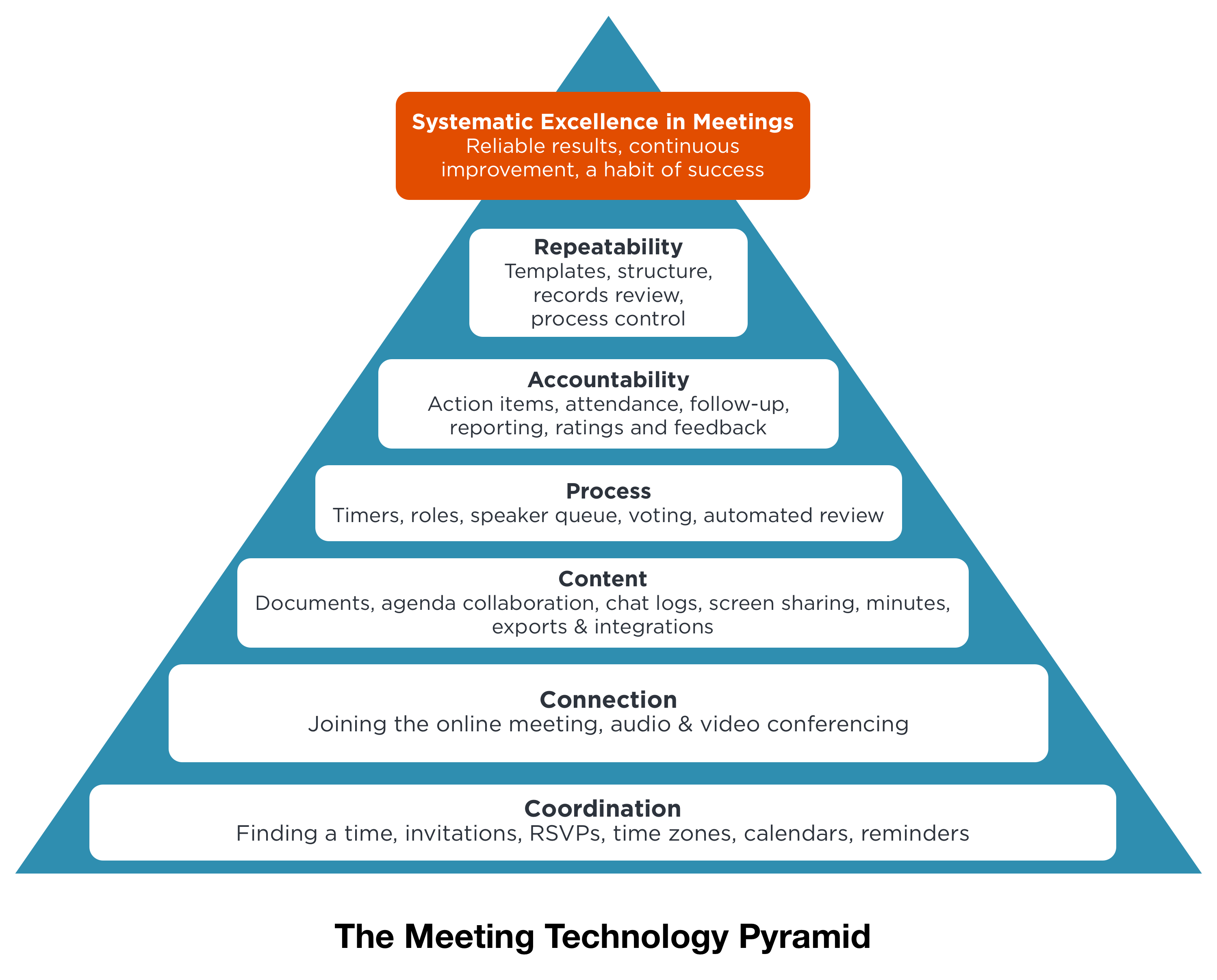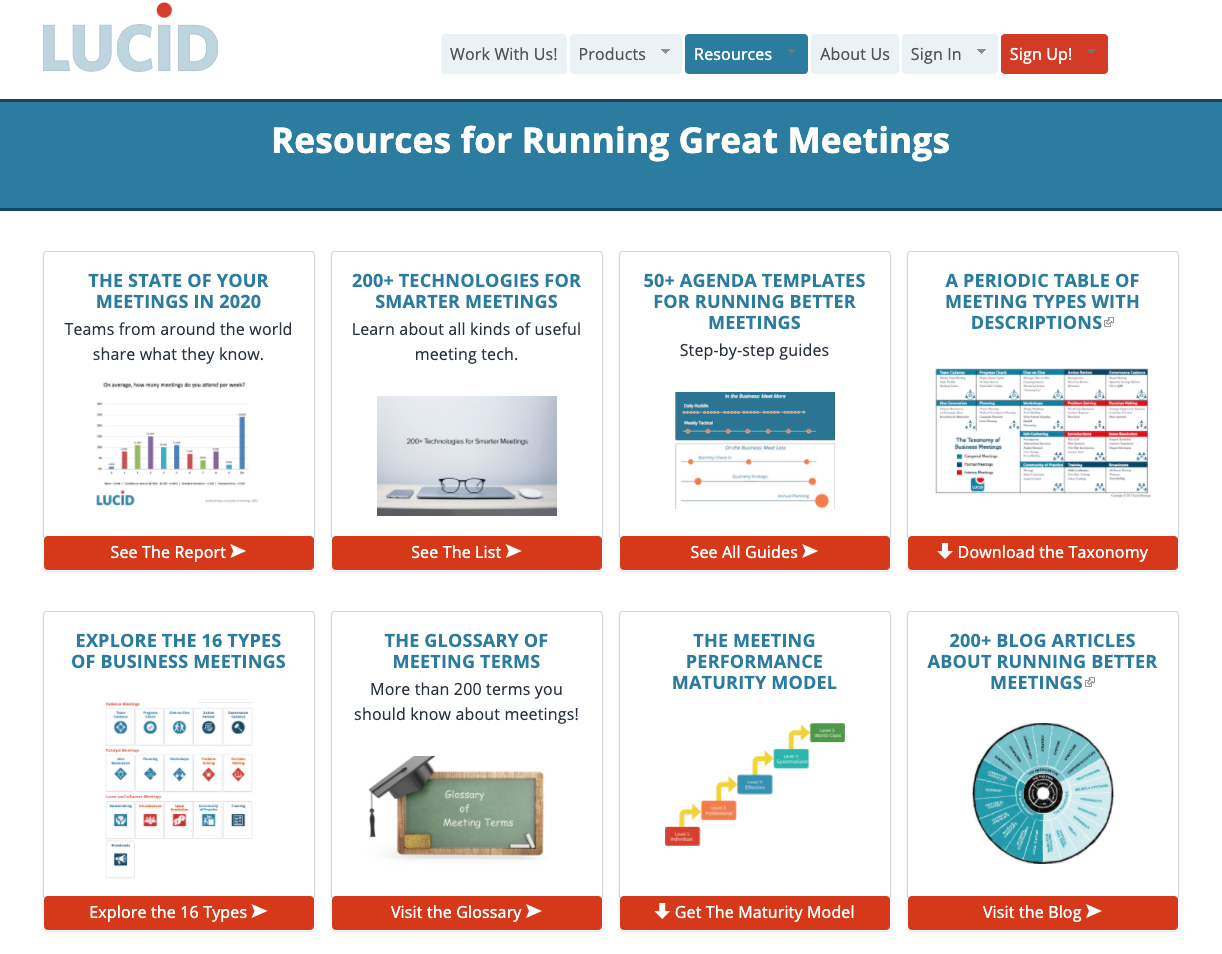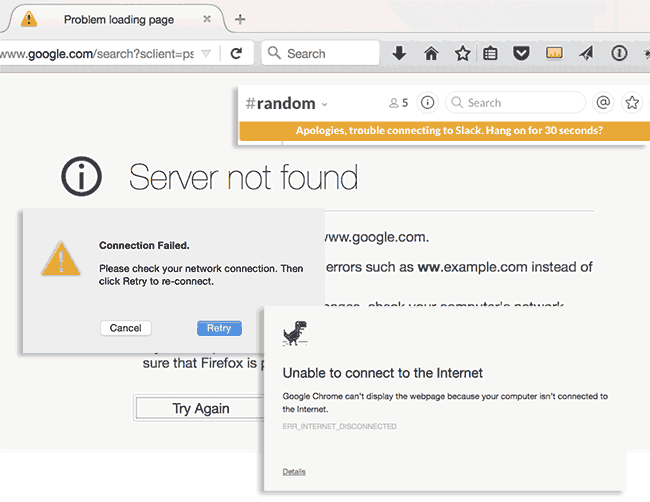How to select the right online meeting platform for any meeting
Download this article as a PDF
Today we’re taking an in-depth look at how to match software features to the type of meeting you’re running, which is the first item in our Top 10 Things to Consider When Purchasing Meeting Software checklist.







Have you ever walked into a meeting where there weren’t enough chairs? Those people shuffling in the back of the room distract everyone and make the group rush through the conversation.
Ever tried to map out your big idea on the whiteboard, only to find that none of the pens work? No matter how vigorously you wave your hands around, you just can’t get your idea across without the picture.
Remember the time you worked so hard to prepare that important presentation, only to fumble about and eventually discover that you had no way to connect to the projector? I still get a sick feeling in my gut about that one.
Most problems with meetings are people problems; lack of preparation, poor meeting skills, boring presentations, bad habits,… the list goes on. But not all of them. To hold a successful, productive meeting, you also need the right equipment. When you don’t have what you need, or when you use software designed for a different type of meeting than the one you’re running, the results are distracting at best and usually far short of the goal.

Using the wrong features for your online meeting is like giving a blank presentation to the board in your underwear – you’re ill-equipped to succeed.
Problems crop up in face-to-face meetings when the room isn’t the right size for the group and the office supplies aren’t right for the work the group is doing. Online meetings have the same kind of problems when you use a system that isn’t designed to support the people invited or the specific work they need to do. Most online platforms are designed to work for a variety of meetings, usually covering a range of similar meeting types, but there are no systems that work well for all meetings.
There is no one-size-fits-all online meeting platform. To further complicate the issue, those that come closest, with the flexibility and the feature depth required to support a wide range of meetings, are also the hardest to learn and most expensive. So how do you choose?
The 3 ways organizations select meeting software:
Option 1: Don’t really choose.
Many smaller groups pick a meeting platform that someone has used before, then work around or ignore any issues that arise when trying to run different kinds of meetings.
Because there’s no central mandate to use a particular system, these teams may switch between a handful of lightweight, low-cost tools. BYOA (bring your own app) reigns, with each meeting organizer picking the system they personally prefer.
This is the “good enough, let’s wing it” approach, which frankly works pretty well for independent teams or small companies with the flexibility to make-do and improvise, and where the need to appear polished outside of the team isn’t so important.
Option 2: IT picks.
This is the most common choice, reflecting the long-standing IT-centric rather than business-centric approach to buying software that dominates corporate software purchasing. When this happens, the company uses an IT-endorsed meeting platform for all meetings, usually one of the “no one gets fired for selecting XYZ Name Brand” choices.
Each team is then supposed to create their own “recipes” of procedures and related systems to make their meetings work. More often, people use the audio and screen sharing, and work around the rest.
Because these generalist systems aren’t designed for the specific needs of any one group, teams never receive training on how to run their meeting process using the software, and most features go unused. According to Wayne Turmel at GreatWebMeetings, “most presenters user fewer than 25% of the available features”.
Option 3: Match one or more meeting platforms to business needs.
This “best tool for the job” approach allows more mature companies to better support and optimize for the unique needs of different meeting types.
When this happens, the systems used by marketing to manage large scale events with the public are different than those used by client services working on customer projects, which may be different still than those used by sales working to close new business.
If you’re on the hunt and looking for alternatives to GoToMeeting, WebEx, or Join.Me, read further to understand exactly what you should be looking for to achieve your business goals.
With that in mind, let’s look at some common feature sets found in online meeting platforms and the meetings for which they’re best suited.
Common Feature Sets Found in Online meeting platforms
All meeting platforms share some common features and assumptions. For instance, all meeting platforms expect there to be more than one person involved, for the meeting to have a defined start and end time, and for there to be a division of responsibilities between the person(s) running the meeting vs. those who aren’t.
After that, you can split the feature sets into two general categories: Those that focus on making it technically possible to communicate vs. those that focus on using technology to achieve specific goals. We’ll briefly cover six of the most common feature sets:
 Audio conferencing
Audio conferencing Web conferencing
Web conferencing Meeting productivity
Meeting productivity Webinars & Webcasting
Webinars & Webcasting Decision support
Decision support Board portals
Board portals
For each feature set, I’ve added links to meeting platforms from companies that showcase each feature set well to give you sense of the range of options on the market today. Like Lucid Meetings, which combines audio conferencing, web conferencing and meeting productivity, many of the products linked below also provide a range of features beyond those discussed in the section where they’re listed.
You know if a meeting platform includes the combination of features you need for your kind of meeting by looking at how many other tools you have to use at the same time to achieve the desired meeting result.
Technical communication features
Originally invented to reduce the need for people to travel to meetings all the time, technical communication features solve the problem of HOW you can meet with people far away, but make no attempt to address WHY you’re meeting or how to do it well.
 Audio conferencing
Audio conferencing
Example products focused on audio conferencing:
Skype, Dialpad Meetings, TurboBridge
Dial-in numbers, VoIP, web & computer audio, international dialing, dial-out, recording, operator assist – conference calling options abound. If you have remote meeting participants, you’ll need some form of audio conferencing. We’ll dive more deeply into navigating audio conferencing options later in this series.
For the moment, what you need to know is this: Audio conferencing is usually developed and priced separately from the rest of the meeting platform.
Many systems integrate with several audio conferencing options, which makes it easier for people who don’t have an existing solution to get up and running. Very few systems require you to use their integrated audio.
This means:
- You can (and often should) pick your audio services separately from the rest of your system.
Larger companies need to negotiate separate audio contracts to manage costs (conferencing is expensive!), and distributed teams need to find audio that works from all locations. - You can have more than one audio service.
Your meeting platform vendor’s integrated audio may work great for your internal team, but not so well with clients. In that situation, having access to an alternate audio service rescues an otherwise failed meeting.
Lucid Meetings integrates several audio conferencing options and also provides way for people to type in a different audio information if they have something that works better for that group.
Related: Meetings Are Serious Business: How to Minimize Costs, Maximize Value, and Master Your Meetings
 Generic web conferencing features
Generic web conferencing features
Example products focused on generic web conferencing:
Join.me, AnyMeeting, GoToMeeting, WebEx
Desktop sharing, application sharing, document presentation and chat features make it possible for people in different locations to look at the same thing at the same time. When most people think about online meeting platforms, they envision these basic web conferencing features.
This feature set represents the electronic equivalent of a conference room, a pen and a notepad. These core features come in handy for most meetings, and make no assumptions about a meeting’s intended outcome nor attempts to improve the quality of the meeting result.
You should assume that your team will need these features, at least some of the time. Lucid Meetings includes basic web conferencing features because they make it possible to easily and quickly show people what you’re talking about and keep the discussion engaging.
Features for specific meetings
If you only schedule meetings to let people “catch up”, “touch base” and “stay in contact”, read no further. You only need to look at systems that make it technically possible for you to talk, because that’s all you’re doing – talking. When you have a goal for your meetings, however, with real work to be done and a hope for real results at the end, using a system designed to help you achieve those results in an online setting makes a world of difference.
 Meeting productivity features
Meeting productivity features
Example products focused on meeting productivity:
MeetingHero, MeetingKing, Less Meeting, Lucid Meetings
Schedule coordination, agenda management, task tracking, note taking, and meeting records – meeting productivity features help groups organize, run, and document their meetings.
Meeting productivity features are all about the Why and What of the meeting. They’re designed to encourage healthy meeting habits before, during and after each meeting, with built in time tracking, email reminders, exportable meeting minutes, and more. Most productivity features also encourage collaboration between meeting participants, making it easy for multiple people to add notes, comments, and other contributions directly to the online meeting record.
Team updates, project meetings, committee & board meetings, and the great bulk of day-to-day working sessions benefit from the focus on the content and outcome made possible by collaborative meeting productivity features.
Related: How to take notes in meetings
 Webinar & Webcasting systems
Webinar & Webcasting systems
Example products focused on webinars:
Webinar Ninja, ON24, GoToWebinar, Adobe Connect for Webinars
Online registrations, “presenter-mode” audio, Q&A panels, branded splash screens, session recording and attendance reports integrated with your sales tools are all common features for webinar and webcasting systems.
Webinars and webcasts may be interactive and engaging, but they aren’t meant to be collaborative experiences. This is one-way communication in real-time. Webinar features are designed to broadcast a message to as wide an audience as possible, usually as part of a marketing communications program.
Presenters need to provide a controlled experience to ensure the message gets across as intended, so webinar systems make sure that attendees can only interact in ways rigidly prescribed by the presenter.
Webinars and webcasts are meant to increase awareness and sales, which makes reporting and follow-up critical to meeting the event’s goal. Also, most webinars are recorded, making it possible for the marketing team to re-use the webinar content on their blog and in their email campaigns.
 Decision support
Decision support
Example products focused on decision support:
MeetingSphere, Powernoodle, 1000minds
Strategic planning and other high-stakes meetings need to result in clear agreements with strong team commitment. When these meetings get bad results, teams and companies fail. Decision support tools provide the infrastructure required to guide groups through these highly structured and complex engagements with the confidence that they will get a tangible result using a proven methodology.
Online brainstorming, idea grouping, priority ranking and voting are all core features of decision support systems.
 Board portals
Board portals
Example products focused on board portals:
Boardvantage, Diligent Board Books, Directorpoint, BoardEffect, Convene
Governed by rigid laws and protocols, boards need a way to prepare for meetings that lets them review sensitive material easily and securely in advance. Records of the meeting must be documented, and to avoid legal trouble, documented in a very specific way. Board portals provide the organization, guidance, and security features required to ensure the board can focus on their business goals while adhering to the rules.
Decision support tools and board portals can be used for remote or in-person meetings, and are the least likely to include integrated web and audio conferencing features. If you intend to use a dedicated decision support or board portal system with remote teams, you will most likely need an additional conferencing system to manage the technical communication aspects of your meetings.
Matching features to the meeting type
Two factors, the meeting purpose and the attendee list, determine the minimal technology you need to be successful. It’s pretty obvious why the type of meeting matters. After all, trying to run a webinar without a way to register attendees or share a presentation simply won’t work.
People often underestimate the importance of picking the right system for your meeting’s audience, but this is where the technical constraints become most apparent. Systems that provide simple connectivity for small teams lack the controls necessary to work with crowds, and those designed to make it easy for grandparents to chat with toddlers lack the professionalism of those designed for working with clients.
The way you pick meeting software to match your audience is similar to how you’d pick a conference room. The key criteria are group size and formality. For some type of meetings, the recommended features change depending on the group, which I’ll cover below.
One-on-one meetings
Just the two of you, talking it out. Whatever the goal, you can usually navigate any technical issues quickly with just one other person to worry about.
Features you need for one-on-ones

Audio-only or other simple systems work well for one-on-ones.
Ad-hoc group call
“Hey – can we quickly check in? Fred’s got a question!”
These unscheduled meetings gather a group to quickly address a single question or issue. People assemble on short notice for a short meeting, with little to no advance preparation.
Features you need for ad-hoc meetings
For groups of 3 to 5 people

When people work remotely, you need a way to quickly get everyone on a call for ad-hoc meetings, but not much more.
For groups of 5 or more
 +
+ 
As the group grows, the conversation flow bogs down and it’s harder to be understood on a conference line. Make sure you have a way to chat and quickly share your screen if you need to get a point across to a larger group.
Status meetings
Status meetings are designed to share information between team members. For them to work well, they must be kept focused and quick.
Online status meetings need a way to efficiently gather and move through information provided by the team.
Features you need for status meetings
 +
+ 
Meeting productivity tools are ideal for status meetings, making it possible for people to provide information in advance. With all the information organized, the leader can focus the meeting on questions and fly through the agenda so people can get back to work.
Audio-only doesn’t work for status meetings
Sure, you might technically cover the information, but if there’s nothing for people to look at and no way for them to directly contribute, they aren’t engaged and they aren’t paying attention.
Related: 4 ways to run status meetings with your remote team that actually work
Planning and decision-making meetings
Planning and decision-making meetings are special. They benefit from significant advanced preparation, and generate the best results when run according to a research-backed methodology.
With these meetings, the strength of the group’s commitment to the result depends on using a meeting platform that supports the leader’s ability to move the group through the selected process and provides ways for all participants to actively contribute.
Features you need for planning and decision-making meetings
For groups of fewer than 10 people, when the work isn’t too charged
 +
+  +
+ 
These meetings require an agenda and clear definition of the desired result, organized using meeting productivity features. You also need access to background information during the meeting, and usually will review one or more reports using web conferencing features. At the end, the resulting plan or decision gets recorded in the meeting record and distributed using the productivity tools.
For large groups and more complicated decisions
 +
+  +
+ 
Many decision support tools encourage anonymous contributions, which can help when the issue is charged. They also provide a guided way to efficiently gather input from a lot of people at once, providing much needed organization to the chaos you otherwise get with larger groups. When you use these tools with everyone at the same time, the meeting leader will also need audio and web conferencing to provide instructions at each step in the process.
Sales Calls and Client reviews
Sales calls and client review meetings drive business – or at least that’s what they’re meant to do. Whether your sales strategy relies on high-polish or approachability, it fails when your client can’t join your meeting or feels like their time is being wasted.
Don’t expect your customers to play in your sandbox! Select a system that will work on Windows or Apple computers and that doesn’t require your customer to install something, download a plugin, or register with a new email address to join your meeting.
Meeting platforms for client meetings must make it possible for the sales person to put forward a well-prepared and professional presentation while offering a fail-proof way for clients to join.
Features you need for sales meetings
For groups of 5 or fewer
 +
+ 
You don’t always have to show your prospect something on a sales call, but you should always be prepared to do so if it comes up.
For groups of 5 or more, and for more important conversations
 +
+  +
+ 
In addition to sharing a polished presentation, sales professionals who want to impress clients will also write down questions, issues, and decisions during the meeting using a meeting productivity system, and will follow up after the call with a thank-you email that clearly lists the next steps.
Related: 5 Easy Tips to Make Your Online Sales Meetings Stand Out
Committee and Board Meetings
Committee and board meetings are collaborative working meetings with lots of extra rules. More than just good ideas, agendas, record keeping, and attendance tracking are mandatory for these groups. Committees and boards typically have longer, more complicated agendas to manage and many reports to review.
Meeting platforms used by boards and committees should support management of this core meeting content.
Features you need for committee and board meetings
For regular meetings
 + (
+ ( OR
OR  )
)
The meeting leader must have a way to organize the meeting and run the group through the meeting content according to plan. The designated note taker records the minutes directly in the system.
For working sessions
 +
+  +
+ 
Committee working sessions typically result in an updated document of some kind – a business plan, a new specification draft, or some other content. The most efficient way to run this real-time document collaboration is to assign one person to share their screen while they update the document, and have others contribute content that can be copied and pasted through chat or meeting notes. Combining the sharing tools in web conferencing with the collaborative and organizational tools of meeting productivity speeds this work along.
Webinars
Most webinars seek to increase market awareness, marketing leads, and ultimately new sales. Open and optional, webinars hope to attract and impress a wide audience.
The best systems for webinars support a highly polished and controlled presentation and the reporting required for the sales and marketing teams to reach out and sell afterwards. If you ever attend a webinar where you can hear other people coming and going, where the presenter has to explain to everyone how to mute, where they have no great way to manage questions, and you register in one system, meet in another, and never get a reminder or follow-up, then you know that company tried to run a webinar using a simple web conferencing tool. Along with marketing’s intended message, they’ve also told everyone that they’re either inexperienced, cheap or both.
Features you need for webinars
 +
+ 
If you’re doing webinars, you should use a webinar system.
Hey, what about video conferencing?
And let us not forget…
 Video conferencing
Video conferencing
Example products focused on video conferencing:
Fuze, Vidyo, iMeet
This one is hard for me. I really want to be an enthusiastic proponent of video conferencing, because it truly makes online meetings more engaging and personal when done well. Unfortunately for our small distributed team, some of whom work from bandwidth-challenged parts of the world, video conferencing fails more often than it succeeds.
Video conferencing enhances online meetings by making it possible to see as well as hear the other participants. With video, you can communicate emotion and nuance in a way that other modes cannot. When it fails, it distracts and disrupts the conversation, often irreparably. Bad video is more than a technical glitch – it’s a meeting killer.
In our experience, video conferencing works best at the extreme ends of the meeting spectrum. For small intimate groups, video works because the group’s existing relationships make it possible to fumble about a bit and laugh off any awkward moments. Also, internal teams who really value video communication can invest in the time and equipment required to make it work reliably.
Advanced webinars and major broadcast events, such as live international webcasts, make video work by limiting the focus of the video to the presenters and through rigorously testing through any issues in advance. Even then, because the bandwidth issues can be so disabling, many webinar presenters will turn off their video when addressing very large audiences or those in areas with weak internet connections.
We’ve integrated Skype video calling with Lucid Meetings and continue to search for other video conferencing options we can feel confident will provide a quality experience to our clients. In general, however, we believe that unless you can invest in equipping your team to succeed or are running big events, video conferencing should be considered a nice-to-have and approached with caution.
Take-aways
- Online meetings systems are designed to support a range of meeting types, but no product supports ALL meetings well. Meetings are not nails, so you should stop trying to use a single online meeting platform hammer.
- Groups have more productive and engaging meetings when they use tools designed for the type of meetings they run.
- For best results, companies and organizations may need to invest in more than one meeting platform.
When you’re in the market for new meeting software, knowing what type of meetings you need to support is the first step. Once you’ve identified the feature set (or feature sets) you need, take a look at the other criteria on the Top 10 Things to Consider When Purchasing Meeting Software checklist, and download the spreadsheet to use when comparing options.



